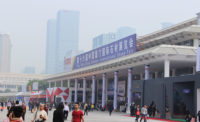Taking a glance at Brazil’s annual statistics, this trend initially doesn’t seem to make sense. Exports of Brazilian granite to the U.S. (the nation’s top export target for stone) reached an all-time high of more than $538 million last year, exceeding the previous year’s total by over 35%. So how is it that individual producers didn’t enjoy that same growth level?
The answer is simple: the playing field of Brazilian granite slab producers is more crowded than ever before. Every time I go to Vitória, it seems there are a dozen more new stoneworking plants in the region than the previous year. And I mean true, state-of-the-art stoneworking plants - with advanced processes and the latest generation of stoneworking technology from Italy.
These plants have a variety of origins. Some are owned by major slab producers in Europe. In fact, the lineup of slab exhibitors at the show in Vitória features many of the same European producers that you would find on hand at Marmomacc in Verona, Italy - only these exhibitors are showcasing their Brazilian plants and materials.
Other slab plants are owned by Brazilian stone producers that have specialized in tile or cut-to-size production in the past, and they are now capitalizing on the growth in U.S. slab consumption.
Yet another trend is the establishment of stoneworking plants by leading Brazilian developers and builders. Many of these plants were developed by the builder to supply their own stone projects, but ultimately expanded into the slab-exporting trade.
And of course, you have those companies that have been in slab production for decades and have continued to move with the times, upgrading their materials and machinery to meet market demands.
So what does this mean for the U.S. market? The first reaction might be to think that this increased competition might result in reduced material prices as American buyers pit one producer against another, but there’s more to it than that. Just as the cheapest is rarely the best in terms of stone fabrication, price shouldn’t be your only factor when purchasing slabs. If you’re importing material, you need to make sure that you’re buying quality products from a company with a solid reputation in the trade. Ask for references and find out their lead times for shipping to the U.S. Do they deliver what they promise? What do their clients say about them? Even fairly “new” Brazilian exporters should have someone who can vouch for their ability to deliver to the U.S.
These days, the American fabricator is facing more competition than ever before, and most have found that selling solely on the basis of price seldom leads to long-term success. Rather, the fabricators who are in it for the long haul are selling quality and customer service. And that begins before the slab even enters your shop. Whether you are importing direct or through a distributor, the key to a quality finished job is starting with quality slabs.



